Over the span of 2 years, Woodpecker has grown a lot faster than we’ve predicted. We have 1000+ customers on board who come from 52 different countries. But what’s more important for today’s blog post, Woodpecker has sent way more than 20 million sales emails throughout all this time.
That number, as impressive as it may seem to our team, is also statistically viable to make some generalization about cold email.
But combined with the numerical data about open and reply rates drawn from the app, as well as the factors influencing those rates from our statistical base, it can serve as a pretty neat report on effective cold email practices.
Practices that can be summed up into 5 key tips that you can consider the next time you’ll be preparing a cold email sales campaign.
You don’t have to follow them wholeheartedly, as there’s no foolproof way of sending cold emails. Every group of prospects responds to various cold email tactics differently. Ultimately, you’re the one who knows your contact group best and you can judge what will work.
I hope, though, that these tips will make you more willing to experiment and find your own ways to reap the most benefits from your cold emails.
Key findings about effective cold emails
I want to share some of the statistics concerning open rate and reply rate that you can take into consideration when you are working on your next email campaign.
Here we show you what we’ve learned.
Double your email reply rate with advanced personalization
When we dove into our statistical data, we found out that personalized emails have an immense influence on reply rate. That rate shows you how many of your cold email recipients messaged you back.
The average response rate of advanced personalized emails (that is those which included custom snippets beyond the most basic ones such as {{first_name}} or {{company_name}}) is 17%. On the flip side, the emails without advanced personalization resulted in 7% response rate.
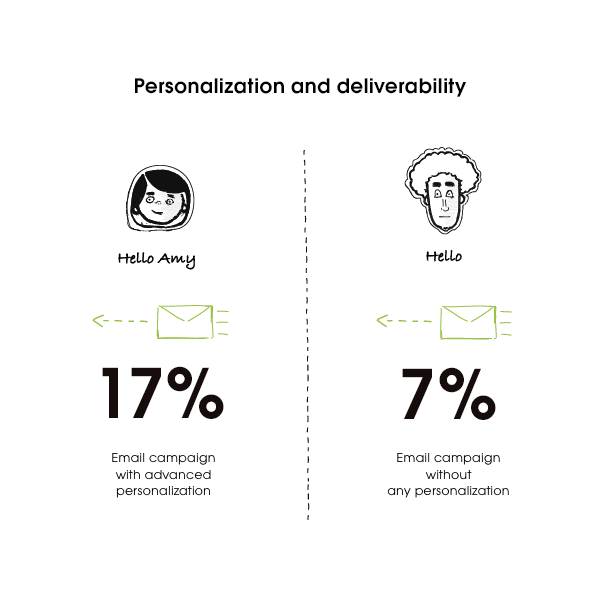
Email personalization is very important. It shows your prospects that you care about their response. And that you were planning on writing specifically to them. Not because their email address appeared on the first page when you typed “graphic designer” into Google.
What’s more, personalization influences deliverability. By enriching your email copy with snippets, you make each of your email copy unique. This, in turn, decreases the chance that your email gets caught up in spam filters.
What you can do about it
With that in mind, try to include around 3 custom snippets with some unique information about your prospects that you’ve come across while doing your research. You can praise their article, congratulate them on something or pick their brains about something you discovered.
For the advice about doing that at scale, check out this blog post, and if you haven’t started doing research yet, read this post about what you should learn about a company.
Cathy also wrote an article about the tools to use for email personalization.
Don’t overdo advanced personalization though. There’s a line between doing it skilfully and coming across as a stalker. Use public and easy-to-find information. If you don’t know what to write about, check the articles above.
A high-quality list of contacts makes your email reply rate skyrocket
Everybody aims at having the highest reply rate possible because it means that they may begin a meaningful conversation with those who responded.
When it comes to this metric, we found out that the quality of your list, together with email personalization, are the most important factors.
To illustrate, let’s imagine that in one campaign you have a contact list of 1K prospects. When your email outreach campaign ends, you get 20 people writing back to you. It translates into 2% reply rate. That’s because you sent an email campaign to an ultrahigh number of prospects and you didn’t bother with email personalization.
But in the other campaign, you have 100 prospects. 40% of them has replied to your emails. That’s 40 replies. You got 40 people who responded to your email. And you’ve done that because you narrowed the target to 100 people and sent out a highly-personalized message sequence.
Well, in both cases there’s a slight danger that those people won’t be interested in what you have to offer. They simply reply with “no, thank you”. And that’s where the importance of personalization and your copy-writing skills come into play.
What you can do to have a high number of positive replies to your cold emails
To gain the most positive reply rates, create a few smaller campaigns addressed to people who will certainly benefit from your solution.
Remember that prospects shouldn’t be placed in the same campaign just because you found their email addresses. All the contacts in one campaign should share a common denominator. It’ll be easier for you to write a copy and personalize the message for them.
Prepare the snippets and write an appealing email copy with an interesting value proposition and a clear CTA.
Moreover, people are going to google you when they receive a sales email from you. Take care of your online presence. Keep your social media profiles up to date. Make sure your website is working. Have some referrals prepared.
What to do if you see a lot of negative replies
First thing first, examine the delivery settings of your follow-ups. If you send too many of them too often and keep regular intervals between them, you may seem aggressive. Make the intervals more varied and extend the time between each follow-up.
If you still don’t know what to do, check your copy. Give your email to a friend to read it and ask them what they think about it. Cross out all the ‘salesy’ terms and expressions. Be more human and focus on recipient more than on your product/service. If you’re using a cold email template you found on the web, throw it out and rewrite your entire sales email. Find your own style.
Maximize your open rate by narrowing down the target group
Open rate is a metric that shows you how many of the prospects, who received your email in their inboxes, took their time to open the email.
Although it’s worth to keep an eye on how many of your messages have been opened, a high open rate doesn’t mean that your campaign met with a huge success. You can have a 96% open rate, but no replies because your email subject line misled your addressees as to what the email is about (a usual spammers tactic).
Similarly, your email copy might look too salesy, or even ‘spammy’ even though your subject line matches the contents of your email. That also doesn’t garner you many replies.
According to our data, cold email campaigns in Woodpecker have around 53% open rate. It’s a decent open rate for an average cold email. However, it doesn’t mean that all campaigns have an open rate like that.
We’ve seen some campaigns that had around 90% open rate.
What you can do about it
To achieve a comparable open rate, you need to take care of email deliverability (undelivered emails cannot be read), write a compelling subject line that’s relevant to the content of your email, polish your “From:” line as well as work on the beginning of your email, that is the introduction.
Nevertheless, even the most amazingly written cold email may remain unopened if you won’t take care of two factors, that is narrow targeting and a small prospect base per campaign.
Successful cold email senders have a small, specifically-defined target group per campaign.
Therefore, give a keyhole narrow targeting a go, and pair it with lowering the number of prospects per campaign.
If you choose prospects who have a thing or two in common, as well as personalize the copy with a couple of custom fields, and then, create a few smaller campaigns, you can achieve a far greater open rate.
Write a campaign to fewer, carefully-chosen contacts to boost cold email reply rate
Our statistical data show that the fewer prospects you have in your email outreach campaign, the higher number of replies you get. You can see that on the infographic. There’s a 10% difference in reply rate between having 1-200 and 1000+ prospect base.
In order to use this data to your advantage, you shouldn’t count that lowering the number of prospects per campaign will miraculously boost your reply rates. That would be too easy, wouldn’t it?
What matters here is to aim your campaign at the companies that share a few common characteristics.
What you can do about it
When building a list of prospects don’t just look for companies that work in the same field. Have a specific set of criteria the business should meet.
For instance, search for SaaS companies from the UK who use Salesforce. Don’t look or something vague, such as “software companies around the world”.
The process will be way smoother to carry out. And it will be easier for you to come up with the ideas for the snippets.
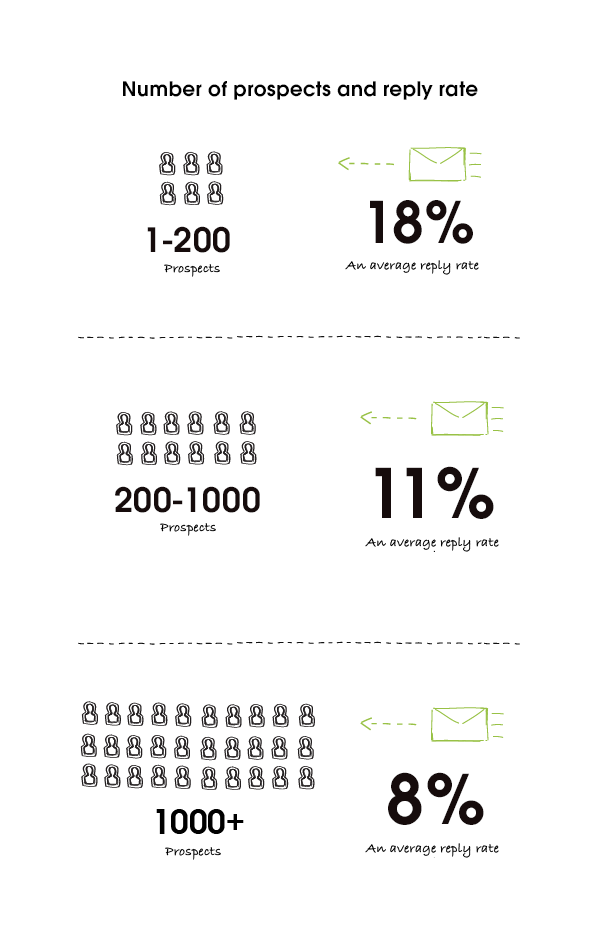
Write more follow-ups to triple cold email reply rate of your emails
We discovered that the reply rate of campaigns with 1-3 emails in a sequence is 9%, and that of campaigns with 4-7 emails in a sequence is three times higher – 27%.
So according to our findings, it’s better to send more follow-ups than fewer.
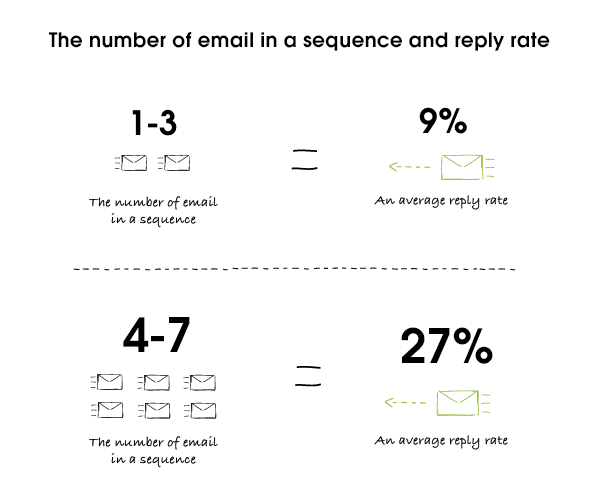
Follow-ups are there to remind your prospects that you’ve tried to reach them before, but they might have been too busy to answer you back first time. In today’s world, they are a must.
However, it doesn’t mean that you should flood your prospects’ inboxes with as many follow-ups as possible until they break and reply to you. It’s not that simple.
What you can do to increase reply rate with following up
First of all, you need to work on their timing. Again, try keeping irregular intervals between your follow-ups. In other words, don’t send them every day at the same time, because you could appear pushy.
Moreover, remember to make your follow-ups valuable. Don’t annoy your prospects by guilt-tripping them that they haven’t responded to your initial email yet. Show them something you found online that relates to their business. Or write about some additional value that the conversation between you two may bring. Remember to keep it short and coherent with your opening message.
You need to experiment to see what works and what doesn’t
What’s in it for you
We hope that all those statistics that we provided here will motivate you to create well-targeted, highly personalized messages even more.
In the previous blog posts, you can find a lot of valuable advice on how to conduct a cold email campaign from start to finish. Cathy talked great lengths about the issues such as deliverability, cold email basics, or building a prospect base.
We also reviewed a bunch of useful contact list building tools to use when you search for prospects.
Exercise for you
Take a deep breath. Log onto your Woodpecker account. Take a look at all of your campaigns and try to identify those with the results that satisfy you the most and the least. Now, try to find correlations between your stats and the advice we give you.
Tell us what you’ve discovered. Maybe you have some other helpful insights you want to tell us about. Share your thoughts in the comments below.
FAQ
What Is the Average Response Rate for Cold Emails?
The average response rate for cold emails varies widely depending on the industry, the quality of the email list, and how personalized the emails are. Generally, cold email campaigns can expect an average response rate of 1% to 5%. Highly targeted and personalized emails tend to be at the higher end of this range.
How Important Are Personalized Subject Lines in Cold Emails?
Personalized subject lines are crucial in cold emails as they significantly increase open rates. Statistics show that emails with personalized subject lines can lead to a 50% higher open rate compared to generic subject lines. Personalization can include the recipient’s name, company, or specific references to their industry or interests.
What Are Some Effective Cold Email Subject Lines?
Effective cold email subject lines are concise, clear, and relevant to the recipient. They should spark curiosity or offer value, making it clear what the recipient can gain from opening the email. Examples include addressing a specific pain point, mentioning a mutual connection, or offering a compelling piece of industry insight.
How Can I Improve My Cold Email Response Rates?
To improve your cold email response rates, focus on personalization, clear and compelling subject lines, a concise and relevant message, and a strong call to action. Follow-up emails are also crucial; they can significantly increase response rates. Testing different approaches and continuously refining your strategy based on what works is key.
What Is the Role of a Call to Action in Cold Emails?
The call to action (CTA) in a cold email is critical to guiding the recipient towards the next step you want them to take. It should be clear, compelling, and easy to act on. Whether it’s scheduling a call, signing up for a demo, or simply replying to the email, a well-crafted CTA can significantly increase your conversion rates.
How Many Follow-Up Emails Should I Send After an Initial Cold Email?
The optimal number of follow-up emails varies, but a sequence of 2-4 follow-ups after the initial cold email is generally recommended. These should be spaced out over a few weeks to avoid overwhelming the recipient. Each follow-up should offer additional value or a new angle on your proposition.
What Is the Impact of Long Subject Lines on Cold Email Performance?
Long subject lines can negatively impact cold email performance. Statistics show that subject lines with 6-10 words tend to have the highest open rate. Subject lines longer than that may get cut off, especially on mobile devices, reducing their effectiveness in capturing the recipient’s attention.
How Does the Click-Through Rate Compare Between Cold Emails and Cold Calls?
Click-through rates for cold emails can vary widely, but they often outperform cold calls in terms of engagement and measurable actions taken by recipients. While cold calls can be effective for immediate feedback, cold emails provide recipients with the opportunity to engage with content at their own pace, potentially leading to higher click-through rates for well-crafted messages.
What Is the Typical Unsubscribe Rate for Cold Email Campaigns?
The unsubscribe rate for cold email campaigns should ideally be below 2%. A rate higher than this could indicate that your emails are not well-targeted, too frequent, or not providing enough value to the recipients. Monitoring and minimizing your unsubscribe rate is crucial for maintaining a healthy email list and ensuring compliance with email marketing regulations.
How Much Time Do Sales Reps Spend Writing Cold Emails?
Sales reps can spend a significant portion of their day writing cold emails, with some estimates suggesting that up to one-third of their time is dedicated to email outreach. This highlights the importance of using effective templates, tools for personalization and automation, and continuously refining email strategies to maximize efficiency and effectiveness.
READ ALSO

Sales Follow-up Emails: 5 Rules to Follow
Cold email senders tend to devote a lot of time to carefully craft our opening message, but usually don’t spend even half of it on writing sales follow-ups. Meanwhile, our experience at Woodpecker shows that the majority of prospects reply to the second or the third message from the sequence, and not directly to the first one. So it looks like we should focus on the follow-ups at least as much as we focus on the opening email. Here are 5 crucial rules to keep in mind when it comes to an effective sales follow-up email.
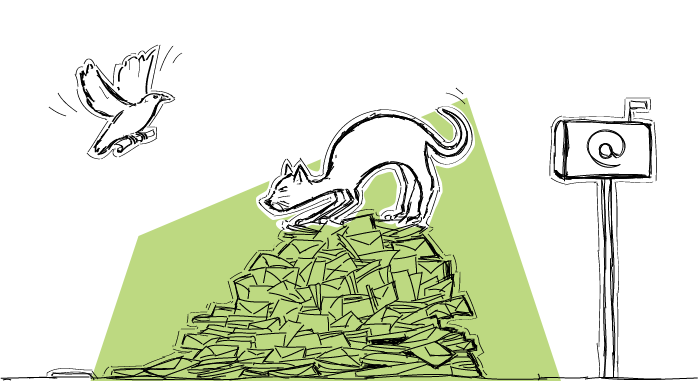
10 Reasons Why Your Cold Emails Are Getting No Response
This week we have a guest post by Nina Cvijovic, who is a researcher and writer at Etools. Nina analyzed 10 reasons why your outbound email campaigns may not be reaching the response rate you expect them to, or are not generating any responses at all. Either way, there's always a field for improvement in cold emailing. So go through the 10 checkpoints below, and read some advice on how your response rates can be improved.
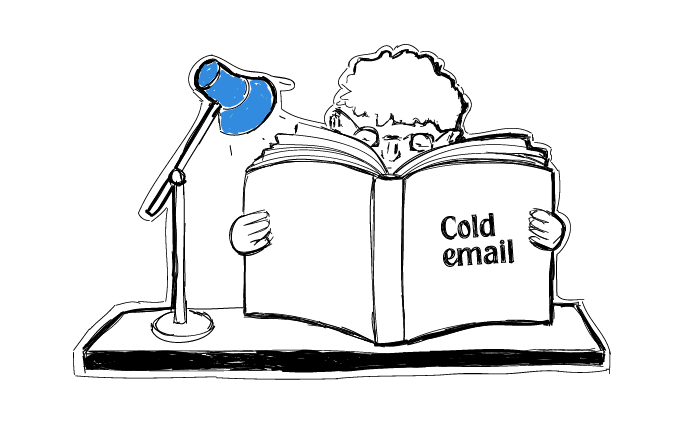
A Comprehensive Guide to Cold Email
This week we have a little special. I've been writing about cold emails for over 2 years. Last week I realized that I've written over 100 posts on this blog so far. That's a lot of material. So this week I decided to prepare a kind of a table of contents, so you have a place on this blog where you can easily and quickly find what you're looking for. Plus, maybe it will allow you to discover some posts you haven't read before. Check out the collection that makes a comprehensive guide to cold email.

